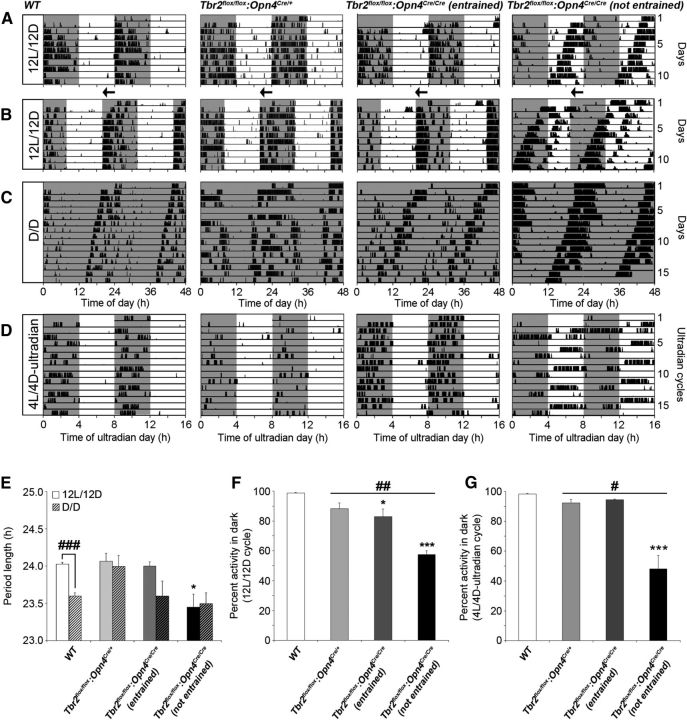Figure 6.
Tbr2 is necessary for normal light entrainment and masking. A–D, Representative double-plotted profiles of wheel-running activity of a WT control (Tbr2flox/flox:Opn4+/+), a Tbr2flox/flox:Opn4Cre/+ mutant, and two Tbr2flox/flox:Opn4Cre/Cre mutant mice, obtained under a 12L/12D cycle (A, B), including after a 4 h phase shift (jetlag paradigm; B), D/D (C), and a 4L/4D ultradian cycle (D). Of five Tbr2flox/flox:Opn4Cre/Cre mice, three showed photo-entrainment to the 12L/12D cycle (entrained to light/dark), and two were unable to photo-entrain (not entrained to light/dark). Mice from all genotypes were able to run freely under D/D conditions. E, Average period lengths of the wheel activity rhythm under 12L/12D and D/D conditions. A two-way ANOVA revealed significant differences between the genotypes (F(3,22) = 4.59, p < 0.01) but not between lighting cycles (F(1,22) = 4.38, p = 0.054) or genotype × lighting cycles (F(3,22) = 1.42, p = 0.28). The genotypes under 12L/12D and D/D were compared using one-way ANOVA, followed by a Tukey's post hoc test (*p < 0.05, compared with WT). A comparison between the two lighting cycles within a genotype was performed using Student's t test (###p < 0.001). F, G, Percentage activity in the dark under 12L/12D (F) and 4L/4D (G) cycles. Data were collected from six WT, four Tbr2flox/flox:Opn4Cre/+, and five Tbr2flox/flox:Opn4Cre/Cre mice. A comparison between WT and combined Tbr2flox/flox:Opn4Cre/+ and Tbr2flox/flox:Opn4Cre/Cre animals was performed using Student's t test (#p < 0.05, ##p < 0.01). Comparisons among the four groups of animals were performed using one-way ANOVA, followed by a Tukey's post hoc test (*p < 0.05, ***p < 0.001, compared to WT). Error bars represent SEM. Shaded areas indicate periods of darkness. Arrows indicate the direction of the 4 h phase shift.

